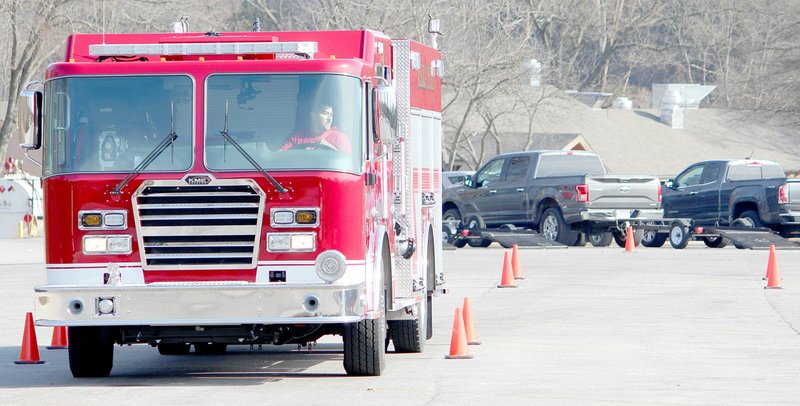The Bella Vista Fire Department hosted an 80-hour driver-operator course over the last two weeks, culminating in a set of tests to certify firefighters as engineers.
Rick McCurdy, assistant instructor with the Arkansas Fire Training Academy in Camden and training officer with the Nob Hill (Washington County east of Springdale) Fire Department, taught the 18 students, primarily consisting of Bella Vista firefighters, though they were joined by a firefighter from Bentonville.
"It's a good class," he said. "Everybody's done good."
The course covers the operations and driving of a fire engine, he said, and also features a series of practical drills -- including pumping water from a lake and driving in town -- before students take written and practical exams to test their knowledge as well as their skill.
The practical exams were in the Kingsdale parking lot.
Those tests, he said, had to be proctored by someone else. As the instructor, he is not permitted to test his students.
The driving test was handled by James Mason, who retired from fire service after 40 years. When he started, he said, he didn't have the luxury of an automatic transmission in his fire engine and had to learn these skills with a third pedal to worry about.
The test, Mason said, has drivers piloting a fire truck through a sea of cones designed to simulate different situations they could encounter -- driving into and backing out of narrow passages, turning around in tight spaces, backing into loading docks, weaving through obstacles forward and backward and tackling tight turns.
Some sections, he said, had only a few inches of breathing room on either side of the truck.
"There's a lot of knowledge in firefighting," he said. "But most of it is skills. If you're a driver-operator, this develops those skills."
Mason said the serpentine section, in which drivers need to navigate a tight slalom in reverse and then again going forward, is what trips up most drivers.
It's not easy, he said, because most of the people taking this course have never piloted anything larger than a pickup truck.
"Very few people come into the fire service with experience driving anything but standard automobiles," he said.
And in addition to driving the huge machines, students had to test on operating the truck's pumps.
That test was handled by David Myers, chief instructor at the Arkansas Fire Training academy in Lincoln.
Running a pump, he said, is all about managing flow.
"You can either put too much water through it or not enough," he said.
An operator needs to figure out how much friction loss is happening through the hoses, which tells the operator how much pressure is needed to overcome the friction. With that in mind, the operator needs to know how much flow is needed at the end of the line, measured in gallons per minute.
Too much flow, he said, could overwhelm a nozzle and actually reduce its output, while not enough will simply lack volume and pressure.
"If you don't get the right amount," he said, "that fire could last forever. It's a lot of responsibility for them as a driver."
Drivers also need to be able to fix any issues that emerge with their pumps, he said.
But provided they can do that and manage flow, he said, fires should go out without too much drama.
One student, Bella Vista firefighter-paramedic Brian Mowery, said he was glad to have some on-shift training before starting class, but all the same he took plenty from the course.
"It was educational," he said.
While firefighters tested, a handful of curious people showed up and watched for a while.
One spectator, Lacey Sauls, took a break from her shift as manager at the Greens at Bella Vista Village II clubhouse to watch a handful of pump tests.
She was glad, she said, to see the department continuing to train its people.
"It's awesome," she said. "Makes me feel safe to see all this training going on."
General News on 02/15/2017
